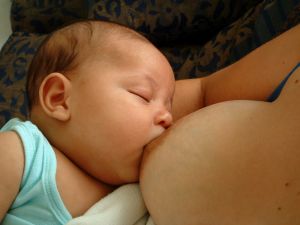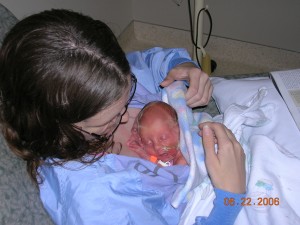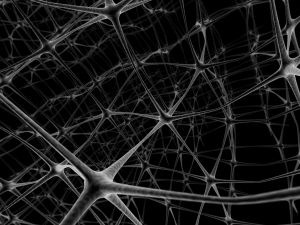From the University of London
 Breastfeeding may be particularly important to the educational and emotional development of children from single-parent and low-income families, new research suggests.
Breastfeeding may be particularly important to the educational and emotional development of children from single-parent and low-income families, new research suggests.
Previous studies have reported that the high nutritional content of breast milk can increase a baby’s IQ. Other research has found that breastfed children are at an advantage because their mothers are, on average, better-off and more articulate.
However, a new study from the Institute of Education, London, which involved 1,136 mothers, strengthens the argument that breastfeeding is also associated with more positive parenting practices that can continue beyond infancy.
Breastfeeding Strengthens Mother-Baby Attachment
Researchers who analyzed the behavior of mothers reading a storybook to their one-year-old children found that, on average, those who breastfed made more effort to engage their infants in the book than mothers who bottle-fed. In general, mothers with more positive attitudes towards breastfeeding also appeared to have a warmer relationship with their babies.
The greatest differences in behavior were between two groups of single and low-income mothers — those who breastfed for six to 12 months, and those who bottle-fed. Poorer women who breastfed interacted with their babies during the book-reading exercise almost as well as more advantaged mothers did. However, low-income mothers who bottle-fed their babies tended to communicate with them much less well than other mothers, the researchers say.
Marital status had no effect on the quality of a mother’s interaction with her child, provided she had breastfed for six to 12 months. In fact, single mothers who had breastfed for this period made slightly more effort than other mothers to explain the storybook to their child.
A repeat experiment four years later found that mothers who had been on a low income when their child was one, but had breastfed for more than six months, had a higher quality of interaction with their five-year-old than other mothers. They also made more effort to engage their child in the book-reading exercise than mothers who had not breastfed. By contrast, breastfeeding appeared to have no lasting effect on the parenting behaviors of married and higher-income mothers.
Study Author: Breastfeeding Especially Important for Single and Low-Income Parents
The report’s principal author, Leslie Gutman, research director of the Institute’s Centre for Research on the Wider Benefits of Learning, says that the age five findings underscore the “protective” influence of breastfeeding for lone parent and low-income families. Future studies should investigate the processes behind the findings, she suggests. Researchers should attempt to establish, for example, whether skin-to-skin contact forms stronger bonds between breastfed infants and their mothers which, in turn, lead to more positive parenting practices.
Report Indicates a Need for Change in Government Policy, Improvement in Education
Gutman also says that the findings provide support for government policies that encourage breastfeeding, particularly for more disadvantaged mothers. “Mothers in such challenging circumstances may face more obstacles to breastfeeding, especially for a longer period of time,” she points out. “They may lack role models and encouragement, or they may be under greater pressure to return to work when their child is still very young.”
If a mother works on a short-term casual basis, or is an agency worker, she may not qualify for maternity leave, and if she earns less than £90 per week, on average, she does not qualify for Statutory Maternity Pay. This may act as an incentive to stop breastfeeding and return to work as soon as possible, the study says.
“New mothers, particularly in deprived communities, may therefore require more than information leaflets,” the researchers comment. “Rather, interventions that offer early and ongoing support and encouragement to manage breastfeeding may be needed: this may come from financial support in order to enable a delay in return to work and/or workplace nurseries where mothers can visit and breastfeed their babies during the day. Meanwhile, campaigns such as ‘Be a star’, run by Blackpool Primary Care Trust (PCT) and North Lancashire Teaching PCT to provide role models for young mothers, may be a way of highlighting the issue.”
The Institute of Education research, which was funded by the Department for Children, Schools and Families, is based on a new analysis of previously unreported data that were originally collected as part of the Avon Longitudinal Study of Parents and Children in the mid-1990s.
Report Also Shows Social Mothers as Having Stronger Attachments with Their Babies
Gutman and her colleagues also found that mothers with extensive social networks interacted with their infants more positively, on average, than mothers with more limited social circles. “At a community level, the finding implies that the networking and social interactions that go on between parents in children’s centres, early-years settings, community groups and many other community venues, such as libraries, and health and leisure centres, are of great value,” they say.
Efforts to improve maternal health could also help to build parenting capabilities as postnatal depression impairs communication between mother and child, the researchers add.
For More Information
“Nurturing Parenting Capability: The Early Years,” by Gutman, John Brown, and Rodie Akerman, can be downloaded at www.learningbenefits.net.
 My dear crying baby,
My dear crying baby, We now have a multitude of studies that show mothers and babies should be together, skin-to-skin (baby naked, not wrapped in a blanket), the baby’s neck extended slightly so his head is in “sniffing position,” immediately after birth – and they should spend as much time together skin-to-skin as possible in the days that follow. The baby is happier, the baby’s temperature is more stable and more normal, the baby’s heart and breathing rates are more stable and normal, and the baby’s blood sugar levels are better.
We now have a multitude of studies that show mothers and babies should be together, skin-to-skin (baby naked, not wrapped in a blanket), the baby’s neck extended slightly so his head is in “sniffing position,” immediately after birth – and they should spend as much time together skin-to-skin as possible in the days that follow. The baby is happier, the baby’s temperature is more stable and more normal, the baby’s heart and breathing rates are more stable and normal, and the baby’s blood sugar levels are better. Biologically, babies need to be carried in order to thrive. Studies have shown that otherwise well-nourished and cared for infants who are deprived of human touch fail to thrive and can even die. Good things happen when baby is carried. Research shows that babies who are held often:
Biologically, babies need to be carried in order to thrive. Studies have shown that otherwise well-nourished and cared for infants who are deprived of human touch fail to thrive and can even die. Good things happen when baby is carried. Research shows that babies who are held often: Breastfeeding may be particularly important to the educational and emotional development of children from single-parent and low-income families, new research suggests.
Breastfeeding may be particularly important to the educational and emotional development of children from single-parent and low-income families, new research suggests. Research has, for many years, shown that the way a child is parented will physically shape his brain — that each interaction, good or bad, will create pathways within the brain as a reflection of the emotions surrounding that interaction. And that a pattern of neglect or abuse will shape the brain differently than will a consistently loving, attachment-promoting relationship.
Research has, for many years, shown that the way a child is parented will physically shape his brain — that each interaction, good or bad, will create pathways within the brain as a reflection of the emotions surrounding that interaction. And that a pattern of neglect or abuse will shape the brain differently than will a consistently loving, attachment-promoting relationship. Nutritional deficiencies in mothers can affect her mental health and lead to inconsistent patterns of mother-child interactions, which in turn increases the likelihood of creating an insecure attachment between the mother and child.
Nutritional deficiencies in mothers can affect her mental health and lead to inconsistent patterns of mother-child interactions, which in turn increases the likelihood of creating an insecure attachment between the mother and child. Your child is naturally imaginative — all children are. Most theories of child development view young children as highly creative, with a natural tendency to fantasize, experiment, and explore their physical and conceptual environment.
Your child is naturally imaginative — all children are. Most theories of child development view young children as highly creative, with a natural tendency to fantasize, experiment, and explore their physical and conceptual environment. Dear Readers,
Dear Readers,
